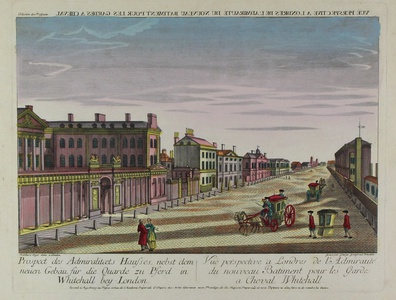| Method | Copper engraving with original hand colouring |
| Artist | Georg Gottfried Winckler after Robbert Soyer |
| Published | Sevend a Ausbourg au Negoce comun de l'Academie Imperiale d'Empire des Arts libereaux avec Privilege de Sa Majeste Imperiale et avec Defense ni d'en faire ni de vendre les Copies [c. 1788] |
| Dimensions | Image 250 x 385 mm, Plate 305 x 400 mm, Sheet 345 x 462 mm |
| Notes |
A vue d'optique of the Admiralty House in Whitehall, London. The title is given in German and French below the image, and the French inscription: 'Vue Perspective a Londres de l'Admiraute du Nouveau Batiment Pour Les Gardes a Cheval' in reverse above the image. Perspective views, or vue d'optiques, are a special type of popular print published in Europe during the eighteenth century. These prints were a form of entertainment meant to be seen through devices called "optical machines," "optiques," "zograscopes" or "peepshows." The prints were exhibited by traveling showmen in the streets throughout Europe and also were collected by those in the professional and upper classes who had the optical machines at home. There was a great curiosity about the appearance of unvisited European cities and exotic locations in the further reaches of the globe, and these prints were one of the only ways the general public could get a look at the wider world. When displayed in the optique, the prints were able to transport the viewer into a far away place-an unknown city, or perhaps into the midst of a dramatic bit of contemporary history or to the distant past. The optical machines used for these prints had a lens which enhanced for viewers the magnification and perception of three-dimensional depth of the scenes depicted. A mirror was often used so that the perspective prints could be viewed when laid flat, and in these cases the images were viewed in reverse. It is therefore not unusual that the scenes shown were drawn in reverse, and there is also often a title printed in reverse along the top, allowing the viewers to quickly read the title. There was usually further text at the bottom of the prints, often in several languages, which could be read by the operator of the optique for the benefit of his audience. The most characteristic feature of the perspective views is their emphasised linear perspective, done to further intensify the enhanced appearance of depth and illusionistic space in the prints when viewed through an optique. Another attribute of these prints is their bright, often crude hand colouring, applied boldly so to show the tints when viewed through the lens. The prints usually have a series of colours-blue, pink and yellow are common-crossing in bands from side to side, with bright highlights often including red. These cheerful and colourful images, with their fascinating history and peculiar appearance, make for unusual and appealing eighteenth-century prints. George Gottfried Winckler (c.1750-80 fl.) was a German engraver working in Augsburg. Condition: Good impression with wide margins. Repair to bottom left of inscription space. Time toning to edges of the sheet. |
| Framing | unmounted |
| Price | £180.00 |
| Stock ID | 47067 |

